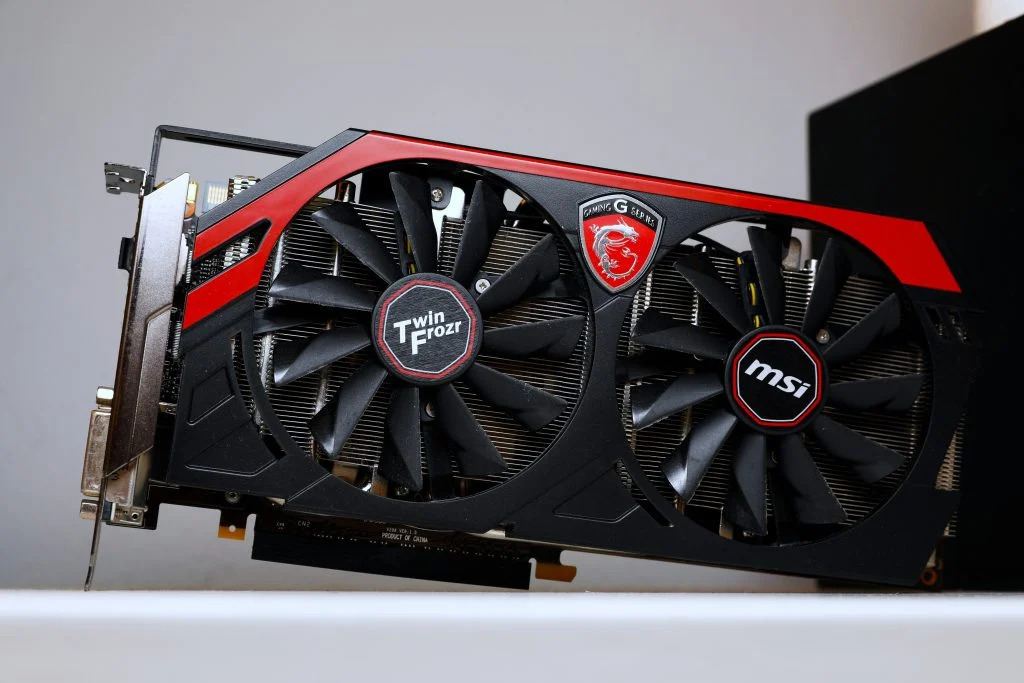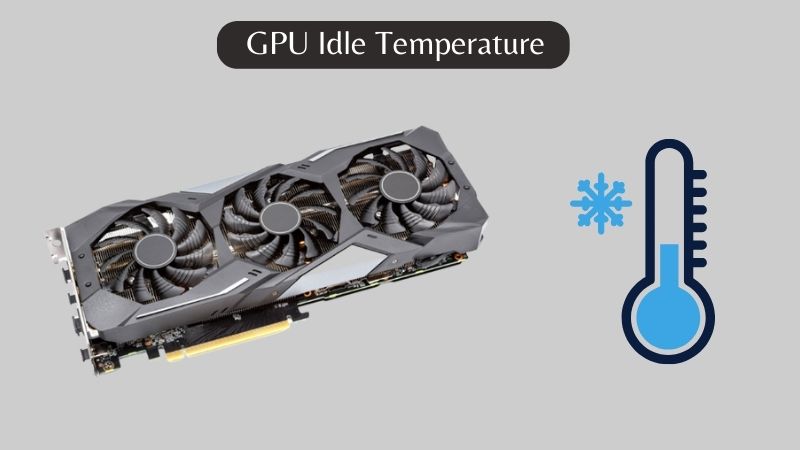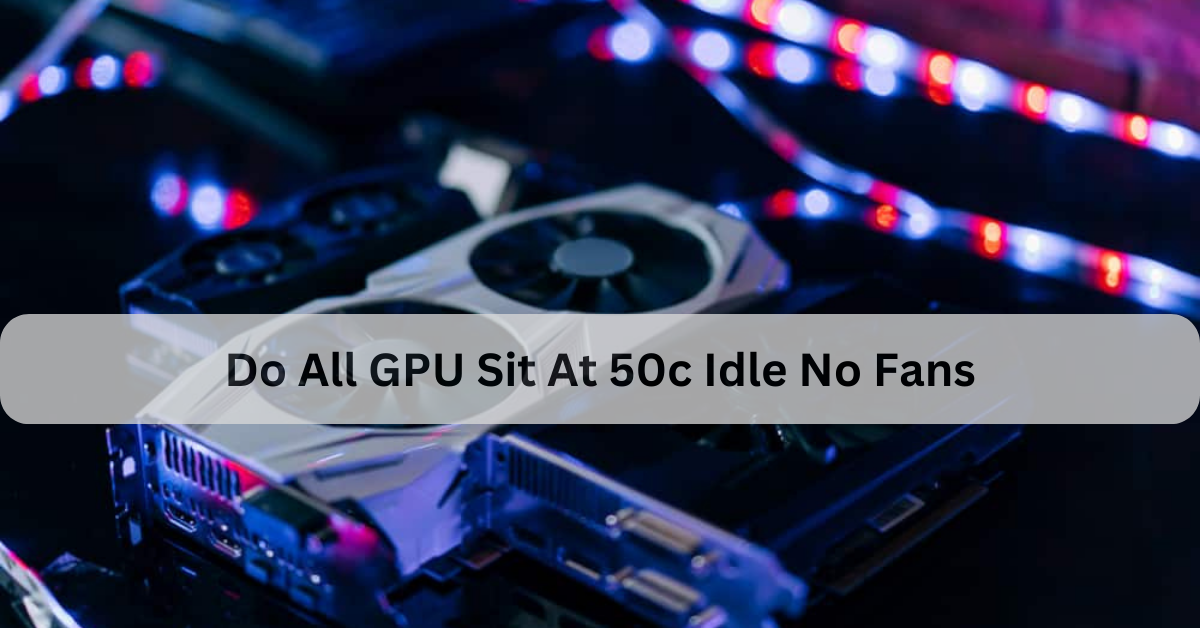Table of Contents
I noticed my GPU idling at 50°C with no fans running and was initially concerned. Turns out, modern GPUs are designed this way to stay quiet when temps are safe—it’s completely normal!
Some GPUs sit at 50°C when idle, and the fans don’t run. This is normal for many modern graphics cards. It helps keep them quiet and efficient.
Some GPUs sit at 50°C when idle, and the fans don’t run. This is normal for many modern graphics cards. It helps keep them quiet and efficient.
Why Do GPUs Idle at 50°C?

Modern GPU Design Philosophy
Modern GPUs are engineered with advanced cooling systems and fan-control algorithms. These systems prioritize user comfort by keeping the fans off when the GPU isn’t under heavy load. This explains why your GPU may idle around 50°C.
Key reasons for this design include:
- Noise Reduction: Fans remain off at idle temperatures to provide a quieter user experience.
- Energy Efficiency: Lower fan activity reduces power consumption, which helps save energy.
- Thermal Thresholds: GPUs are designed to handle idle temperatures of up to 60°C safely.
Comparison with Older GPUs:
Older GPUs typically ran fans continuously, even at idle. This made them noisier and less energy-efficient compared to modern GPUs, which only activate fans when temperatures exceed a set threshold (usually 60°C).
Is 50°C Safe for Your GPU at Idle?
Yes, 50°C is completely safe for most GPUs when idle. Manufacturers design their GPUs to handle much higher temperatures under load.
Here’s a quick breakdown of safe GPU temperature ranges:
- Idle Temperatures: 30°C – 60°C
- Under Load: 65°C – 85°C
If your GPU idles at 50°C, there’s no need to worry unless it goes higher.
Read More: My GPU Has Only 1 HDMI Port – Complete Guide 2024!
Why Don’t GPU Fans Run at Idle?
GPU fans are programmed to turn on only when needed. Typically, they start spinning when the GPU temperature exceeds 60°C. This is part of the fan-stop feature that many modern graphics cards, such as NVIDIA and AMD GPUs, include.
The benefits of this design include:
- Longer Fan Lifespan: Less wear and tear on the fans since they don’t run constantly.
- Quieter Performance: No fan noise during light tasks like browsing or watching videos.
- Improved Energy Usage: Reducing unnecessary fan use saves power.
What If Your GPU Exceeds 50°C at Idle?

While 50°C is normal, idle temperatures above 60°C may indicate an issue. Some common causes include:
- Dust Buildup: Dust can block airflow and increase temperatures.
- Poor Airflow in the Case: Insufficient ventilation can trap heat inside your PC.
- High Ambient Temperature: Hot room temperatures can raise idle GPU temps.
- Incorrect Fan Curve Settings: The fan curve might need adjustment if the fans don’t spin when needed.
How to Lower GPU Idle Temperatures
Clean Your GPU and PC Case:
Dust can block airflow and trap heat, making your GPU run hotter. Use compressed air to clean your GPU, fans, and inside the case. This will improve airflow and help your system cool down better.
Improve Case Airflow:
Good airflow is important to prevent heat buildup. Make sure your case has enough fans, and they are positioned to push and pull air efficiently. You can also consider adding extra fans if your case has room for them.
Adjust Fan Settings:
With tools like MSI Afterburner, you can control when your GPU fans start spinning. By adjusting the fan curve, you can make the fans spin earlier or faster, which helps lower temperatures at idle.
Check Thermal Paste:
Over time, thermal paste can dry out, causing poor heat transfer from the GPU to the cooler. If your GPU is old, consider reapplying new thermal paste. This can help lower the temperatures and improve performance.
Keep Your Room Cool:
High room temperatures can make your GPU run hotter. Keep your room well-ventilated by opening windows, using a fan, or turning on air conditioning, especially during warmer months. This can significantly lower your GPU’s idle temperatures.
Read More: Which Display Port To Use On GPU – Complete Guide 2024!
What’s the Difference Between Modern and Older GPUs?
| Feature | Modern GPUs | Older GPUs |
| Performance | High (4K, ray tracing) | Low (1080p) |
| Architecture | Smaller (7nm, 5nm) | Larger (28nm, 40nm) |
| Ray Tracing | Supported | Not supported |
| VR & AI | Optimized | Not supported |
| Power Consumption | More efficient | Less efficient |
| Memory | Larger, faster (8GB+) | Smaller, slower (2GB) |
| Software Support | Latest APIs, drivers | Limited support |
| Price | Expensive | Affordable |
| Cooling | Advanced (multi-fan) | Simple (single fan) |
| Size | Larger, complex | Smaller, simpler |
Should You Adjust Your GPU’s Fan Curve?
Adjusting your GPU’s fan curve can help reduce idle temperatures, but it’s not always necessary. Modern GPUs are designed to handle idle temperatures of 50°C safely without fan intervention.
If you want to customize your fan settings, use software like:
- MSI Afterburner
- EVGA Precision X1
- AMD Radeon Software
Keep in mind that running fans at lower temperatures may increase noise and wear out the fans faster.
Frequently Asked Questions:
1. Why does my GPU stay at 50°C even when I’m not gaming?
Modern GPUs are designed to stay at low idle temperatures, typically between 30°C and 60°C. When the GPU isn’t being used for heavy tasks like gaming, the cooling system is optimized to remain passive, meaning the fans don’t run. This helps conserve power and reduces noise.
2. Can a GPU overheat if it sits at 50°C?
No, 50°C is a safe temperature for most GPUs when idle. However, temperatures above 60°C at idle could indicate an issue, like dust buildup, poor airflow, or incorrect fan settings.
3. Do all modern GPUs have fan-stop technology?
Most modern GPUs, especially those from NVIDIA and AMD, are designed with fan-stop technology. This allows the fans to remain off during idle or light usage to reduce noise and power consumption.
4. How can I check the temperature of my GPU?
You can monitor your GPU temperature using software tools such as MSI Afterburner, HWMonitor, or GPU-Z. These programs provide real-time temperature readings and other performance metrics.
5. Is 50°C too high for my GPU when gaming?
No, 50°C is well within the safe range for a GPU, even during gaming. Under load, GPUs can safely operate between 65°C and 85°C, depending on the model and manufacturer.
6. How can I make my GPU cooler while idling?
To lower GPU idle temperatures, you can improve case airflow, clean the GPU and other components, adjust fan curves, reapply thermal paste, or ensure that the room temperature remains cool.
7. What are the risks of running my GPU with the fans off?
Running your GPU with the fans off at idle is generally safe as long as the temperature stays within the normal range (below 60°C). However, if the fans do not activate when needed or the GPU temperature rises too high, there is a risk of overheating, which can lead to reduced performance or hardware damage.
8. How often should I clean my GPU to maintain optimal temperatures?
It’s recommended to clean your GPU and PC case every 3 to 6 months, depending on the amount of dust buildup in your environment. Regular cleaning helps maintain proper airflow and cooling efficiency.
9. Does my GPU need additional cooling if it idles at 50°C?
In most cases, no additional cooling is necessary if your GPU is idling at 50°C. However, if your temperatures rise above 60°C at idle, you may need to improve airflow in your case or check the cooling system.
10. Should I manually control my GPU fans to keep temperatures lower?
While modern GPUs have automated fan control systems that are typically sufficient, you can manually adjust the fan curve using software like MSI Afterburner. However, keep in mind that setting the fans to run constantly can increase noise and may shorten the lifespan of the fans.
Conclusion:
Its completely normal for a GPU to idle at 50°C without the fans running. Modern GPUs are designed to operate quietly and efficiently at these temperatures. As long as your GPU doesn’t exceed 60°C at idle, there is no need to worry. Regular cleaning and proper airflow can help keep temperatures under control.
If temperatures rise beyond 60°C, it’s important to check for issues like dust or airflow problems. Adjusting fan curves is optional, but usually not necessary for most users.
